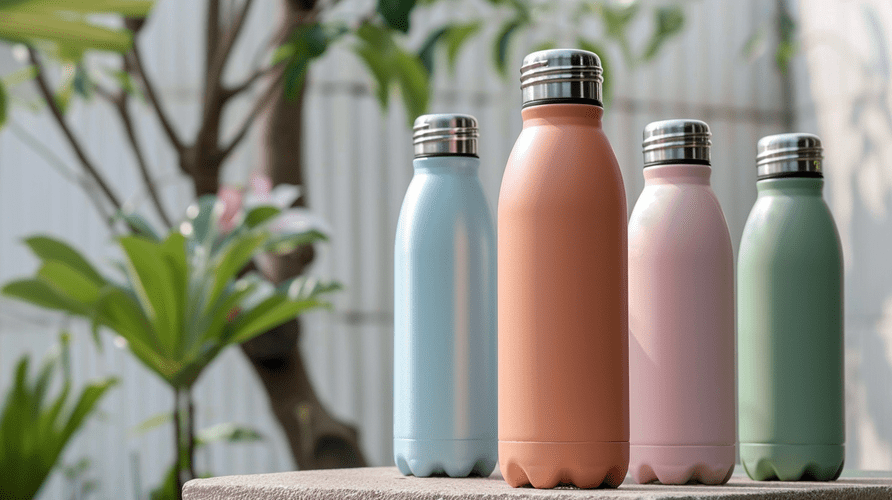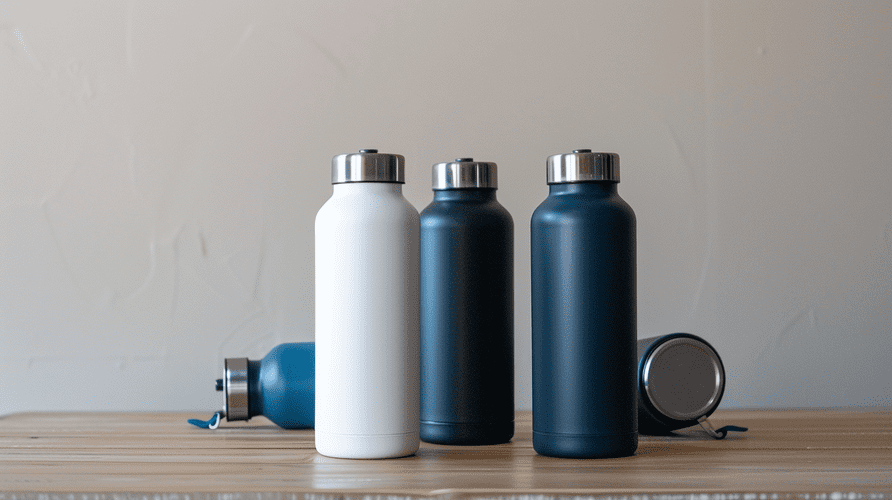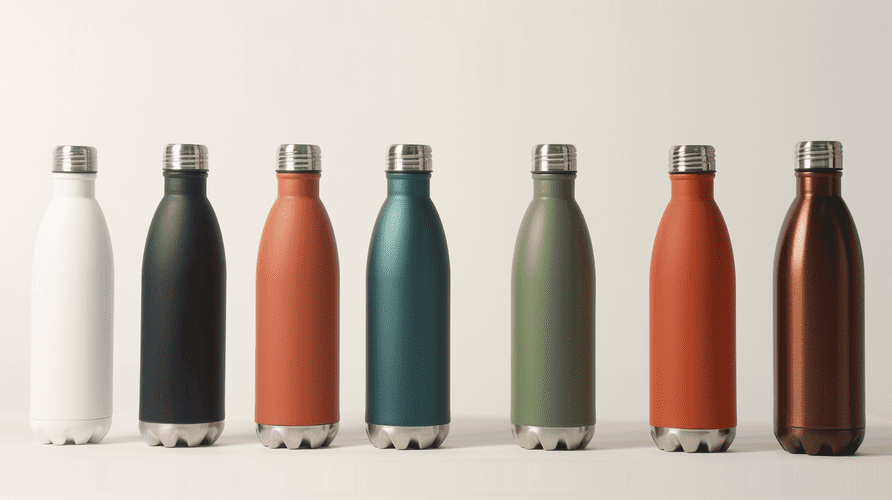Choosing the right material for products can be stressful. Make the wrong choice, and you risk quality issues and unhappy customers. Stainless steel often emerges as the superior option.
Stainless steel is favored by procurement officers for its excellent durability, corrosion resistance, and safety, especially for food and beverage products. It offers long-term value and a premium feel that reflects well on a brand, ensuring reliability in the supply chain.

You need materials that perform reliably and look good for your brand. But understanding the specific advantages can be tricky. Let's explore exactly why stainless steel stands out in the B2B world, particularly for products like drinkware. This knowledge helps you make informed purchasing decisions and justify them confidently.
Why is stainless steel better than other materials?
Comparing materials like plastic, glass, or aluminum feels overwhelming. Each has pros and cons, but choosing incorrectly impacts budgets and product performance. Stainless steel provides a balanced solution.
Stainless steel often outperforms other materials due to its unique combination of strength, longevity, non-reactivity (safety for food/drink), and recyclability. It resists rust, doesn't break easily like glass, and avoids potential chemical leaching associated with some plastics.

Digging Deeper: Stainless Steel vs. The Alternatives
When I talk with procurement officers like Mark, the comparison often comes down to practical factors. They need reliability and value. Let's break down how stainless steel1 stacks up against common alternatives for products like water bottles or mugs.
Stainless Steel vs. Plastic
Plastic might be cheaper upfront, but it often lacks durability. It can crack, warp, and absorb odors or flavors. Concerns about BPA and other chemicals leaching into contents are also significant, especially for food-grade products. Stainless steel, particularly grades like 304 (18/8), is inert, meaning it doesn't react with food or drinks, ensuring safety and purity. While the initial cost might be higher, its lifespan makes it more cost-effective long-term.
Stainless Steel vs. Glass
Glass offers excellent purity and doesn't leach chemicals. However, its fragility is a major drawback in many applications, especially for portable items. Breakage leads to waste and potential safety hazards. Stainless steel provides similar inertness but with vastly superior impact resistance. For items that are handled frequently or transported, steel is simply more practical and durable.
Stainless Steel vs. Aluminum
Aluminum is lightweight and recyclable. But, it often requires an inner lining (like epoxy resin) for food and beverage containers to prevent reaction with acidic contents, which raises questions about the lining's durability and safety. Aluminum also dents more easily than stainless steel. Stainless steel's inherent corrosion resistance2 eliminates the need for such liners.
Here's a simple comparison:
| Feature | Stainless Steel (304) | Plastic (Typical) | Glass | Aluminum |
|---|---|---|---|---|
| Durability | Very High | Low to Medium | Low | Medium |
| Food Safety | Excellent | Variable (BPA?) | Excellent | Needs Liner |
| Corrosion Resist. | Excellent | Varies | Excellent | Poor (needs liner) |
| Weight | Medium | Very Low | Medium-High | Low |
| Impact Resist. | High | Medium | Very Low | Medium-Low |
| Cost (Initial) | Medium-High | Low | Low-Medium | Low-Medium |
| Cost (Long-Term) | Low | Medium-High | High (due to breakage) | Medium |
| Recyclability | High | Varies | High | High |
For buyers focused on quality, safety, and long-term value, stainless steel consistently proves to be a reliable choice.
What is unique about stainless steel?
You see stainless steel everywhere, but what makes it fundamentally different? Just thinking it's strong or shiny misses the key point. Its core composition is the secret.
The most unique feature of stainless steel is its self-healing protective layer3. Chromium in the steel reacts with oxygen to form a passive chromium oxide film. This invisible layer resists corrosion and rust, making it exceptionally durable and hygienic.

Digging Deeper: The Science Behind the Shine
That passive layer is what truly sets stainless steel apart. It's not just a coating; it's an integral part of the metal itself. If the surface gets scratched, the chromium quickly reacts with oxygen in the air or water to reform the protective layer. This self-repairing quality is vital for longevity and maintaining a clean surface.
The Protective Layer Explained Simply
Think of it like incredibly tough, invisible skin that instantly heals itself. This "skin" prevents oxygen and water from reaching the iron in the steel, which stops rust from forming. This is crucial for drinkware or food containers because it means no metallic taste and no rust contamination over time, even with daily use and washing. It addresses Mark's concern about quality directly – this feature ensures the product stays high quality.
Common Stainless Steel Grades
Not all stainless steel is the same. For food and beverage products like the ones we make at Icobottle, the most common and trusted grade is Type 304, also known as 18/8 stainless steel. This designation means it contains approximately 18% chromium and 8% nickel. The chromium provides corrosion resistance, while the nickel enhances formability and durability. Using the right grade is critical for performance and safety compliance – something vital for avoiding certification issues Mark worries about.
Hygiene and Customization Benefits
Because the chromium oxide layer4 makes stainless steel non-porous and smooth, it doesn't harbor bacteria easily and is simple to clean thoroughly. This is essential for health and safety. Furthermore, this stable surface is excellent for customization. We can apply various colors, finishes, and logos reliably, knowing the underlying material provides a durable and safe base. This allows brands to create premium, lasting products.
What are 3 uses of stainless steel?
Wondering where this versatile material actually gets used? Is it just for forks and knives, or is it broader? Its properties make it suitable for many demanding applications.
Beyond kitchenware, three major uses for stainless steel are: 1. Food and beverage containers (like bottles, mugs, flasks). 2. Medical instruments and implants. 3. Architectural elements and industrial equipment.

Digging Deeper: Versatility in Action
The unique combination of corrosion resistance, strength, hygiene, and aesthetic appeal makes stainless steel incredibly versatile. Let's look at these three areas and why stainless steel excels in each.
Food and Beverage Containers
This is our core business at Icobottle. Stainless steel (especially 18/8) is perfect for hip flasks, water bottles, coffee mugs, and tumblers. Why?
- Safety: It doesn't react with liquids, preventing leaching and metallic tastes.
- Durability: It withstands drops and daily wear-and-tear far better than glass or plastic.
- Temperature Retention: When used in double-walled vacuum-insulated designs, it keeps drinks hot or cold for hours.
- Hygiene: Easy to clean and doesn't retain odors or flavors.
- Aesthetics: Offers a premium look and feel, ideal for branded merchandise.
For procurement officers supplying branded goods, these factors ensure customer satisfaction and product longevity.
Medical and Surgical Tools
The requirements here are extreme: absolute sterility, high corrosion resistance (against body fluids and sterilization processes), and durability. Stainless steel meets these needs. Surgical instruments, implants (like hip replacements), and hospital equipment rely on specific grades of stainless steel for their non-reactive, cleanable, and strong nature. This highlights the material's inherent safety and reliability.
Architectural and Industrial Uses
Look around cities and factories. You'll see stainless steel used for building facades (like the Chrysler Building spire), bridge components, kitchen appliances, chemical processing tanks, and automotive parts. Here, its resistance to environmental corrosion, structural strength, and sometimes its modern appearance are key factors. Its ability to withstand harsh conditions makes it essential in many demanding industrial settings. This broad applicability underlines its proven performance across diverse, critical sectors.
Why do people prefer stainless steel appliances and products?
Think about high-end kitchens or popular branded water bottles. Why is stainless steel so often the preferred choice? Is it just about looking modern? It's actually a mix of practical benefits.
People prefer stainless steel products5 largely because they associate it with quality, durability, and cleanliness. It offers a sleek, modern aesthetic combined with resistance to rust, stains, and odors, making it a practical and long-lasting investment.

Digging Deeper: The Appeal of Steel
For procurement officers sourcing products like drinkware, understanding why the end-users (and by extension, their own clients like Mark) value stainless steel is important. It's not just one thing, but a combination of factors that create a strong preference.
The Premium Look and Feel
Stainless steel undeniably has a high-quality appearance. Its clean lines and metallic sheen convey modernity and professionalism. For branded items like the water bottles Mark sells, this aesthetic elevates the brand's image. It looks and feels substantial, unlike some cheaper plastic alternatives. This perceived value is a significant selling point.
Long-Term Value and Durability
Stainless steel products last. They resist dents better than aluminum, don't shatter like glass, and don't degrade or become stained like plastic often does. For a business buyer, this means fewer returns or complaints, and for the end-user, it means a product they can rely on for years. This durability translates directly into better long-term value, even if the initial cost is slightly higher. This addresses Mark's sensitivity to both quality and competitive pricing over the product's lifecycle.
Ease of Maintenance and Hygiene
As mentioned before, stainless steel is easy to clean. It doesn't readily absorb food particles or bacteria, and it resists staining. This is crucial for anything that comes into contact with food or drink. For appliances, it means less scrubbing. For drinkware, it means confidence in cleanliness and safety. This practical benefit is highly valued by consumers and reinforces the quality perception. It also simplifies compliance with health standards.
Combining these factors – looks, longevity, and ease of care – makes stainless steel a consistently popular and trusted choice for both consumers and B2B buyers sourcing quality goods.
Conclusion
Stainless steel offers unmatched durability, safety, and versatility. Its unique properties make it a preferred material for procurement officers seeking reliable, high-quality products with lasting value.
-
Explore this link to understand the unique benefits of stainless steel, including its durability and safety for food and drink. ↩
-
Discover why corrosion resistance is crucial for material selection and how stainless steel excels in this area. ↩
-
Explore this link to understand how the self-healing layer enhances the durability and hygiene of stainless steel, making it a superior material. ↩
-
Discover the science behind the chromium oxide layer and its role in preventing rust and corrosion in stainless steel products. ↩
-
Explore the benefits of stainless steel products, including durability and aesthetic appeal, to understand why they are a top choice for consumers. ↩

